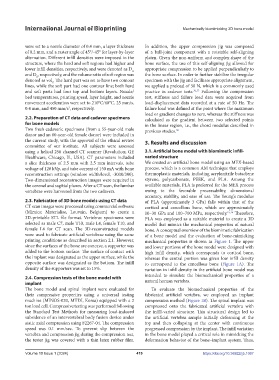Page 427 - IJB-10-1
P. 427
International Journal of Bioprinting Mechanically biomimicking 3D bone model
were set to a nozzle diameter of 0.4 mm, a layer thickness In addition, the upper compression jig was composed
of 0.2 mm, and a raster angle of 45°/-45° for layer-by-layer of a ball-joint component with a rotatable self-aligning
alternation. Different infill densities were imposed in the platen. Given the non-uniform and complex shape of the
structure, where the hard and soft regions had higher and bone surface, the use of this self-aligning jig allowed for
lower infill densities, respectively, and were denoted as D appropriate compression to be applied perpendicularly to
H
and D , respectively, and the volume ratio of soft region was the bone surface. In order to further stabilize the irregular
S
denoted as vol . The hard part was set to have two contour specimen with the jig and facilitate appropriate alignment,
S
lines, while the soft part had one contour line; both hard we applied a preload of 50 N, which is a commonly used
and soft parts had four top and bottom layers. Nozzle/ practice in cadaver tests. 36,37 Following the compression
bed temperatures, printing speed, layer height, and nozzle test, stiffness and failure load data were acquired from
movement acceleration were set to 210°C/60°C, 25 mm/s, load-displacement data recorded at a rate of 50 Hz. The
0.4 mm, and 450 mm/s , respectively. failure load was defined at the point where the maximum
2
load or gradient changes to zero, whereas the stiffness was
2.2. Preparation of CT data and cadaver specimens calculated as the gradient between two selected points
for bone models in the linear region, i.e., the chord modulus described in
Two fresh cadaveric specimens (from a 55-year-old male previous studies. 38
donor and an 80-year-old female donor) were included in
the current study, with the approval of the ethical review 3. Results and discussion
committee of our institute. All subjects were assessed
using a helical 256 channel CT scanner (Revolution; GE 3.1. Artificial bone model with biomimetic infill-
Healthcare, Chicago, IL, USA). CT parameters included varied structure
a slice thickness of 2.5 mm with 2.5 mm intervals, tube We created an artificial bone model using an MEX-based
voltage of 120 kVp, and tube current of 150 mA with bone process, which is a common AM technique that employs
reconstruction settings (window width/level, -3000/300). thermoplastic materials, including acrylonitrile butadiene
Two-dimensional reconstruction images were acquired in styrene, polycarbonate, PEEK, and PLA. Among the
the coronal and sagittal planes. After a CT scan, the lumbar available materials, PLA is preferred for the MEX process
vertebrae were harvested from the two cadavers. owing to the favorable processability, dimensional
accuracy, stability, and ease of use. The Young’s modulus
2.3. Fabrication of 3D bone models using CT data of PLA (approximately 3 GPa) falls within that of the
CT scan images were processed using commercial software cortical and cancellous bone, which are approximately
(Mimics; Materialise, Louvain, Belgium) to create a 10–30 GPa and 100–700 MPa, respectively. 15,16 Therefore,
3D-printable STL file format. Vertebrae specimens were PLA was employed as a suitable material to create a 3D
selected as male C7, male T10, male L4, female T10, and model that mimics the mechanical properties of natural
female L4 for CT scan. The 3D-reconstructed models bone. A conceptual overview of the biomimetic fabrication
were used to fabricate artificial vertebrae using the same of a bone model and the evaluation of bone-mimicking
printing conditions as described in section 2.1. However, mechanical properties is shown in Figure 1. The upper
since the surfaces of the bone are concave, a supporter was and lower portions of the bone model were designed with
added to the bottom surface. The surface of contact with high infill density, which corresponds to cortical bone,
the implant was designated as the upper surface, while the whereas the central portion was given low infill density
opposite surface was designated as the bottom. The infill to correspond to the cancellous bone (Figure 1A). The
density of the supporters was set to 15%. variation in infill density in the artificial bone model was
intended to simulate the biomechanical properties of a
2.4. Compression tests of the bone model with natural human vertebra.
implant
The bone model and spinal implant were evaluated for To evaluate the biomechanical properties of the
their compressive properties using a universal testing fabricated artificial vertebra, we employed an implant
machine (MINOS-020, MTDI, Korea) equipped with a 2 compression method (Figure 1B). The spinal implant was
ton load cell. Compressive testing was performed following compressed onto the fabricated artificial vertebra with
the Standard Test Methods for measuring load-induced the infill-varied structure. This structural design led to
subsidence of an intervertebral body fusion device under the artificial vertebra sample initially deforming at the
static axial compression using F2267-04. The compression top and then collapsing at the center with continuous
speed was 0.1 mm/sec. To prevent slip between the progressed compression by the implant. The infill variation
vertebra and compression jig during the compression test, in the bone model played a critical role in mimicking the
the tester jig was covered with a thin latex rubber film. deformation behavior of the bone–implant system. Thus,
Volume 10 Issue 1 (2024) 419 https://doi.org/10.36922/ijb.1067

